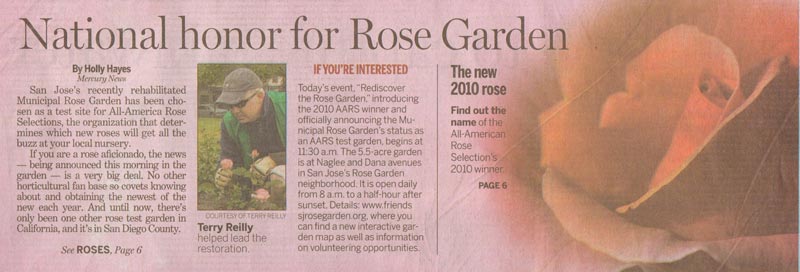By Holly Hayes
Mercury News
Posted 05/02/09
San Jose’s recently rehabilitated Municipal Rose Garden has been chosen as a test site for All-America Rose Selections, the organization that determines which new roses will get all the buzz at your local nursery.
If you are a rose aficionado, the news — being announced this morning in the garden — is a very big deal. No other horticultural fan base so covets knowing about and obtaining the newest of the new each year. And until now, there’s only been one other rose test garden in California, and it’s in San Diego County.
“Being an AARS test garden will truly make San Jose a destination for garden clubs from hundreds of miles around,” says Terry Reilly, co-founder of Friends of the San Jose Rose Garden. The organization was formed in 2007 to coordinate a massive volunteer effort to rescue the local treasure from years of neglect.
Tom Carruth, president of AARS and an award-winning rose hybridizer for Southern California-based Weeks Roses, says his organization had been “struggling to find and keep a test garden in Northern California for a number of years because we did not have one representing your climate zone. It’s a great rose-growing climate.”
Carruth — a rock star of the rose world — will participate in today’s “Rediscover the Rose Garden” event. He says his fellow “rose nuts” are a unique, passionate breed.
“It’s an interesting phenomenon. The rose has always been a beloved flower. People can be intimidated by them, but they love them anyway,” Carruth says. “When the bug bites, that’s when the desire for the newest and best kicks in hard. No other plant has that level of devotion to the new.”
For the San Jose test garden, four beds were constructed along the Dana Avenue side to hold the 38 varieties — four plants of each type — that are competing for future AARS status. The plants are identified only by numbered tags; judges are not told who the breeders are or the companies they represent. Test roses put in the beds this year will be evaluated for two years, and the eventual winner — or winners, as is more often the case — will be introduced to the public in 2013.
A few of the plants have started to bloom. One of the first was a warm pink hybrid tea tagged only with the code “09R208.”
“Each has something different to offer,” Reilly says. “It’s sort of like Christmas morning when they start to open up. It’s a great way to see the future.” The roses are grouped by type; hybrid teas (numbered 200s), grandifloras (300s), floribundas (400s) and landscape, or shrub roses (500s).
Reilly and a small panel of judges will be keeping an eye on the test plants for eventual judging on 15 key characteristics, including disease resistance, ease of maintenance, flower production, color and fragrance.
And they won’t be pampered.
“The test roses don’t get special treatment,” Reilly says. “The idea is to give them the same amount of care the average home gardener would give.”
AARS members recently voted to remove fungicidal spraying from the testing process, starting this year, to ensure that the winners are top performers without any help. In the majority of the Municipal Rose Garden — which has some 4,000 rose shrubs with 189 varieties represented — neem oil is used as a fungicide to control aphids, mildew and black spot.
Four new beds will be constructed sometime this year to hold the varieties that will be tested starting in 2010.
AARS roses include some of the most popular in history: Peace (1946), Mister Lincoln (1965), Double Delight (1977), Knock Out (2000), Hot Cocoa (2003) and Julia Child (2006). At nurseries, AARS roses are identified by their signature red-rose tag.
The AARS trial program has existed since 1938, and there currently are 23 test gardens nationwide, representing all climate zones. The only other test site in California is in Carlsbad in Southern California, and the expansive Portland Rose Garden — to which rose devotees make regular pilgrimages — is the only other West Coast venue.
Until recently, no one would have called the Municipal Rose Garden a destination. Weed-choked and bedraggled, the garden had been a victim of reduced city maintenance and poor horticultural practices, and the AARS put its accreditation as a public display garden on probation.
Reilly and Beverly Rose Hopper rallied volunteers to come to its aid; since September 2007, volunteers have logged more than 6,000 hours pruning, weeding, working on irrigation systems and mulching. More than 735 new roses — all donated — have replaced plants that were failing or too far gone to rehabilitate.
Reilly and his troops consider the renovation complete. Still, it takes a core cadre of 150 trained “master volunteers” — they’re the ones wearing the stylish green vests — to keep things looking sharp. This group collectively puts in about 48 hours a week, in addition to the maintenance work performed by the city.
Inexperienced rose lovers are invited to participate in quarterly volunteer events, usually scheduled when the thousands of roses need to be pruned or have spent blossoms removed, a process called deadheading.
The AARS was so impressed by the local volunteer effort to bring back the garden that it now offers a case study to other public gardens on how Reilly and Hopper designed the public-private partnership.
Says Reilly: “Other gardens are now taking advantage of all the hard work we did here.”


